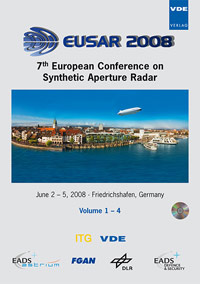Long-Term and Short-Term Surface Deformation Mapping by Repeat-Pass Satellite SAR
Conference: EUSAR 2008 - 7th European Conference on Synthetic Aperture Radar
06/02/2008 - 06/05/2008 at Friedrichshafen, Germany
Proceedings: EUSAR 2008
Pages: 4Language: englishTyp: PDF
Personal VDE Members are entitled to a 10% discount on this title
Authors:
Wang, Chih-Tien (Institute of Space Science, National Central University, Jhongli, Taiwan)
Chen, Kun-Shan (Center for Space and Remote Sensing Research, National Central University, Jhongli, Taiwan)
Lee, Jong-Sen (Jong-Sen Lee, Naval Research Laboratory, Remote Sensing Division, Washington DC)
Boerner, Wolfgang-Martin (University of Illinois at Chicago, USA)
Abstract:
The prevailing complex geological and ecological conditions of Taiwan have drawn considerable attention from various geo-ecological communities because of their vulnerability to produce various natural hazards at different scales. Located in the tropical/subtropical zone of the Pacific Rim, its ecological and rugged mountainous properties are environmentally sensitive making monitoring and observations especially difficult because of the high population density. For example, in terms of natural hazard mitigation tectonically active regions are used for analyzing the cause of abundant risk events, such as earthquakes, landslides and land subsidence. In fact Taiwan is well suited as a test site for studying those geologically disastrous processes. Implementing novel techniques of space remote sensing has proved to be an effective means in recent years for greatly improving our understanding of these phenomena. In this paper we report on the monitoring of such events using multi-modal polarimetric and/or interferometric SAR images at C and L band from ERS, JERS-1, RADARSAT-1, ENVISAT, and from the recent ALOS satellite. For crustal and surface deformation, we used radar image pairs with long temporal baselines and large areas of coverage for investigating deformation over Western Taiwan. Pre-seismic and co-seismic deformation patterns are spatial-temporally analyzed. The other topic deals with the coastline changes observed from a sequence of ERS-1/2 SAR images within the years of 1996 to 2005. Waterlines were extracted using multi-scale procedures of edge detection and were corrected with tidal motion data. Substantial analyses were carried out in conjunction with ground surveys and lidar mapping. The topographic feature changes due to large scale landslides triggered by torrential rains were also monitored. In addition, the SAR interferograms were used to analyze the deposition changes along the riverbeds and riverbanks for short-intervals using optimal baselines. Summary and remarks on the implementation of such multi-modal polarimetric and/or interferometric SAR imagery for environmental monitoring are provided.


